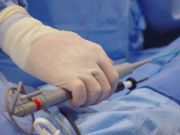CHOICE: Balloon-Expandable Sapien Valve Shows Early Edge over CoreValve Self-Expandable Device
Results from the CHOICE trial presented at ACC.14 showed the Sapien balloon-expandable valve performed slightly better than the CoreValve self-expanding device according to a composite measure of "device success."

As transcatheter aortic valve replacement (TAVR) becomes established as a strategy to treat severe aortic stenosis in patients who otherwise would not be good surgical risks (as we reported yesterday with the results from the CoreValve Study), clinicians will need to make informed choices as they weigh different prosthetic valve choices.
Investigators leading the independently funded CHOICE trial conducted the first head-to-head comparison of a self-expandable prosthetic aortic valve versus a balloon-expandable valve in symptomatic high-risk patients with severe aortic stenosis. The results, presented March 30, 2014, during a Late-Breaking Clinical Trials session at the American College of Cardiology 2014 Scientific Session in Washington, DC, slightly favored Edwards’ Sapien balloon-expandable valve over Medtronic’s CoreValve self-expanding device -- but with several caveats.
Mohamed Abdel-Wahab, MD, of the Segeberger Kliniken Heart Center in Bad Segeberg, Germany, presented information on the CHOICE study’s design, methods, outcomes, and results. Five German medical centers enrolled a total of 241 patients, who were then randomly assigned to receive the Edwards Sapien XT balloon-expandable valve (n=121) or the self-expandable Medtronic CoreValve (n=120).
Patients were included if they were assessed as having severe aortic stenosis including aortic valve area, New York Heart Association (NYHA) functional class of 2 or more, advanced age (older than 75 years), and high surgical risk assessed by a variety of measures. The native aortic valve annulus and patient’s anatomy must also have been suitable for transcatheter approach with one of the two valves.
In addition to anatomic unsuitability, exclusion criteria included life expectancy of less than 12 months, as well as hemodynamic instability, history of active endocarditis, active gastrointestinal disease, infection, planned surgery, or contraindication to antiplatelet therapy. All procedures were completed via the transfemoral approach.
Following valve deployment, angiographic assessment was performed immediately after placement; researchers also obtained transthoracic echocardiography and invasive hemodynamic measurement. Valve Academic Research Consortium (VARC) standards were followed to assess aortic regurgitation (AR). A pre-specified group of patients received magnetic resonance imaging (MRI) with regurgitant fraction (RF) calculated. Laboratory studies, including complete blood count and renal and liver function tests, as well as electrocardiograms, were obtained during subjects’ inpatient stay.
A composite measure of device success was defined as the primary endpoint of the trial. Device success in this context consisted not only of successful delivery and deployment of the prosthetic valve, but also of correct positioning resulting in intended performance (without more than minor AR), and no need to repeat the procedure. This term is defined by VARC consensus statement.
The CHOICE trial established multiple secondary end points for the 30-day mark; some of these included mortality, major and minor bleeding or vascular complications, improvement in NYHA status, a composite safety endpoint, and a composite major adverse cardiovascular and cerebrovascular event (MACCE) endpoint. A device-blinded committee adjudicated whether endpoints had been achieved for all subjects.
Clinical outcome for both groups was excellent at 30 days. Rates of major stroke and mortality were low in both groups. However, the incidence of greater than mild paravalvular regurgitation, as well as total AR, at 30 days as documented by echocardiography was lower for the Sapien balloon-expandable device group than for the Medtronic CoreValve self-expanding device group (paravalvular: 9.9% vs. 7.2%, P = 0.009; total AR: 2.1% vs. 9.6%, P = 0.04). More than mild AR was also more common after initial implant in the CoreValve group (12.4% vs. 42.5%, P < 0.001), as was any AR (40.5% vs. 74.2%, P< 0.001).
For the VARC-defined secondary safety endpoint, both devices were comparable at 30 days, at which point more patients had new permanent pacemakers or had a rehospitalization for heart failure in the CoreValve self-expandable valve group than in the Sapien balloon group. However, the vast majority of patients in each group reported symptomatic improvement by at least one NYHA class: 94.3% of the Sapien balloon group and 86.5% of the CoreValve self-expandable group.
The authors identified several potential limitations of the CHOICE study, including not augmenting AR assessment perioperatively with echocardiography, though the authors pointed out the several steps taken to validate angiographic findings.
In discussion after the presentation, panelists noted that in contrast to the CoreValve findings presented yesterday, the CHOICE study followed patients out to just 30 days. The CoreValve self-expandable device may continue to expand and “settle” over a longer period of time, resulting in less AR over time; thus, the 30-day window may have been too brief to capture the eventual function of the self-expandable valve. Differences in patient selection between the two studies were highlighted as well. Data collection is ongoing and Abdel-Wahab anticipated continued fine-tuning of TAVR study results.